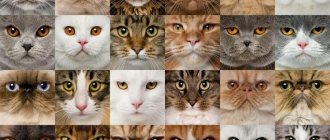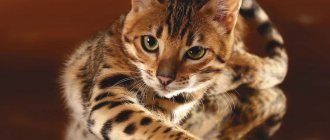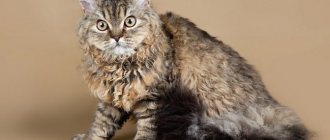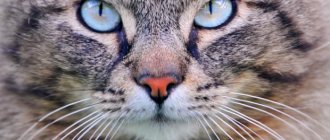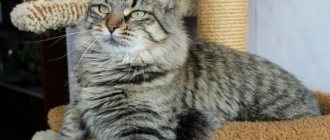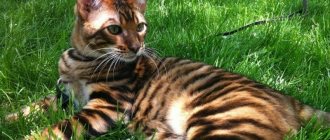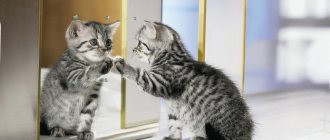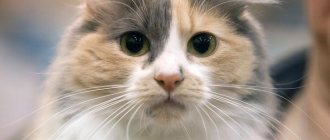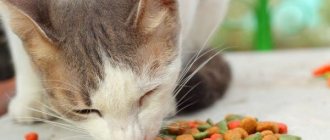Often, when we hear the adjective “smoky,” we associate it with smoke and gray light. In fact, smoky is a coat color in which each hair of an animal has two or more colors. Due to this, a hazy effect and uneven color appears. There is a smoky color in different shades. The exact color you end up with is influenced by the set of genes that forms a particular pigment. Pet breeding specialists have long compiled a palette of possible haze in cats
. Now we will figure out what colors smoky cats come in.
First, let's pay attention to the smoky color based on a dark dominant pigment. It, in turn, is divided into two subtypes: full smoky and diluted smoky.
Smoky cat
Smoky colored cats are very popular. Mist rocks are credited with mystical properties and superpowers. The peculiarity of such cats is their unusual appearance. The fur has the ability to change tone in different lighting. In the sun it shimmers with bright colors, and in twilight lighting it seems monochromatic. You can look at this for hours without taking your eyes off. The smoky cat is a symbol of nobility and thoroughbred. Real beauties who will not leave a single person indifferent. A variety of breeds with smoke color will allow you to make a choice to your liking.
Tabby colored breeds
There are more than 20 cat breeds, among which there are tabby cats. For some breeds, this type of pattern is the only possible one.
Example of breeds with tabby capability:
- British;
- Siberian;
- Pixie bob;
- Bengal;
- Scottish;
- Ceylon;
- Persian;
- Safari;
- Toyger;
- Sokoke.
Sokoke cat
Some of the breeds have specific types of patterns. For example, British shorthairs are especially good in marbled tabby, Persian longhairs are distinguished by their frequent tortoiseshell coloration, toygers are interesting in mixing spots with stripes, and Abyssinian cats are most valuable in lilac colors (fawn). While color variations are possible in the breeds listed above, only all representatives of the breeds described below are presented in tabby coloring.
Abyssinian
Despite the name of the breed, there is still debate about its origin: African (Egypt) or Indian. The short-haired breed has a long-haired counterpart - the Somali cat is native to North America.
Abyssinian ticked cat
A significant area of their body appears to be a solid color, but the tail, paws and face may be marked with typical tabby patterns. The traditional “M” is often emblazoned on the forehead, and the eyes and nose are brightly outlined. The patterns clearly appear on the wool, but their color usually differs from the main one by only a few tones. Ticked color predominates. Common shades for Abyssinian and Somali cats: reddish-brown-black, reddish-yellowish, bluish-lilac.
Singaporean
All Singapura cats have the same color. The main color of the coat is from ivory to dirty gray with dark gray or brownish streaks.
Singapore tabby cat
The tabby color is predominantly ticked. Among the distinctive features of the breed pattern are:
- darkening on the back and front of the knees;
- shadows on the paws in the area of the feet;
- intermittent pattern on the forehead and muzzle.
Egyptian Mau
The Egyptian Mau's coloration is formed naturally. Tabby type - leopard. Among the signs that allow us to classify a cat as a given breed, we will focus on the main ones:
- many spots of different sizes scattered throughout the body in a chaotic manner;
- various shapes of spots;
- contrastingly different color of the spots from the main shade of the coat;
- a clear “M” on the forehead, the pattern creates the impression of a frown on the cat;
- lines from the forehead go down, going down the back of the neck to the back, where they increase and break up into spots;
- characteristic lines on the cheeks;
- clear “necklaces” on the chest and neck of dotted lines;
- bracelets on the top of the front paws.
Egyptian Mau
The coat of the Egyptian Mau is characterized by the following colors: silver, bronze, haze, black, black haze.
Ocicat
The breed was bred artificially by crossing representatives of the spotted tabby breeds - the Abyssinian is one of the ancestors of the Ocicat. Outwardly, the Ocicat resembles a small leopard or Ocelot - an almost exact copy of a wild cat in a reduced size.
The color of Ocicat cats has several features:
- bright markings on the forehead, muzzle, paws and tail;
- a pattern in the form of chaotic spots on the body, paler than on the muzzle;
- Possible creamy, almost white markings on lips, cheeks, neck, chest and paws.
The Ocicat looks like a small leopard
The primary color (golden markings on an ivory background) was gradually diluted by others during selection: chocolate, bluish, lilac, violet, golden, silver with shades.
Mongrel cats
Often outbred pets also have a tabby pattern from birth, which indicates that they belong to the most beautiful color type. Moreover, such cats boast a variety of colors and patterns that cannot always be obtained through long-term purebred selection.
Story
The history of the smoky cat began quite recently, in 1975; the first kittens of the new breed appeared only at the end of 1980.
It took more than 10 years to finally breed the breed, but it was worth it. The first name of the overseas breed was “spotted mist”, which comes from the English word smoky. Later the name Australian Mist was assigned to the breed.
For a long time, the breed was recognized only in Australia, and therefore did not spread throughout the world. More recently, the smoky cat was identified as a separate breed in the international organization of felinologists and TICA.
The most interesting thing is that the smoky cat has no Australian predecessors; they were all brought to Australia. There have never been any felines on the mainland under natural conditions.
Tabby colored breeds
There are more than 20 cat breeds, among which there are tabby cats. For some breeds, this type of pattern is the only possible one.
Example of breeds with tabby capability:
- British;
- Siberian;
- Pixie bob;
- Bengal;
- Scottish;
- Ceylon;
- Persian;
- Safari;
- Toyger;
- Sokoke.
Sokoke cat
Some of the breeds have specific types of patterns. For example, British shorthairs are especially good in marbled tabby, Persian longhairs are distinguished by their frequent tortoiseshell coloration, toygers are interesting in mixing spots with stripes, and Abyssinian cats are most valuable in lilac colors (fawn). While color variations are possible in the breeds listed above, only all representatives of the breeds described below are presented in tabby coloring.
Abyssinian
Despite the name of the breed, there is still debate about its origin: African (Egypt) or Indian. The short-haired breed has a long-haired counterpart - the Somali cat is native to North America.
Abyssinian ticked cat
A significant area of their body appears to be a solid color, but the tail, paws and face may be marked with typical tabby patterns. The traditional “M” is often emblazoned on the forehead, and the eyes and nose are brightly outlined. The patterns clearly appear on the wool, but their color usually differs from the main one by only a few tones. Ticked color predominates. Common shades for Abyssinian and Somali cats: reddish-brown-black, reddish-yellowish, bluish-lilac.
Singaporean
All Singapura cats have the same color. The main color of the coat is from ivory to dirty gray with dark gray or brownish streaks.
Singapore tabby cat
The tabby color is predominantly ticked. Among the distinctive features of the breed pattern are:
- darkening on the back and front of the knees;
- shadows on the paws in the area of the feet;
- intermittent pattern on the forehead and muzzle.
Egyptian Mau
The Egyptian Mau's coloration is formed naturally. Tabby type - leopard. Among the signs that allow us to classify a cat as a given breed, we will focus on the main ones:
- many spots of different sizes scattered throughout the body in a chaotic manner;
- various shapes of spots;
- contrastingly different color of the spots from the main shade of the coat;
- a clear “M” on the forehead, the pattern creates the impression of a frown on the cat;
- lines from the forehead go down, going down the back of the neck to the back, where they increase and break up into spots;
- characteristic lines on the cheeks;
- clear “necklaces” on the chest and neck of dotted lines;
- bracelets on the top of the front paws.
Egyptian Mau
The coat of the Egyptian Mau is characterized by the following colors: silver, bronze, haze, black, black haze.
Ocicat
The breed was bred artificially by crossing representatives of the spotted tabby breeds - the Abyssinian is one of the ancestors of the Ocicat. Outwardly, the Ocicat resembles a small leopard or Ocelot - an almost exact copy of a wild cat in a reduced size.
The color of Ocicat cats has several features:
- bright markings on the forehead, muzzle, paws and tail;
- a pattern in the form of chaotic spots on the body, paler than on the muzzle;
- Possible creamy, almost white markings on lips, cheeks, neck, chest and paws.
The Ocicat looks like a small leopard
The primary color (golden markings on an ivory background) was gradually diluted by others during selection: chocolate, bluish, lilac, violet, golden, silver with shades.
Appearance
The smoky cat has an unusual appearance and is one of the short-haired felines. This cat cannot be called not beautiful, and now you will understand why. All representatives of this species are small in stature, however, they cannot be called small. Their body is medium in size with fairly well-developed muscles, which is clearly visible when the cat moves. The chest and shoulders also stand out well.
The large head is attached to the body with a medium-length neck. The muzzle is small and obtuse. The eyes are also medium in size. Their colors vary from yellow to green. The mustache is also small. The nose is medium with a noticeably prominent hollow. The ears are proportional to the head, stand erect, and their tops are rounded.
The tail is also of medium size in length and thickness. It is noteworthy that the tip of the tail is elegantly rounded. The stockiness of the animal is given by its medium-length, well-developed legs ending in small, soft oval paws. The toes are always tightly closed. The entire body of the animal is covered with uniform dark fur, which to the touch is similar to mink fur.
Breeds for which only gray coat color is acceptable
Among the varieties of cats, there are those that are characterized only by an ash-colored coat. These breeds include:
- Russian blue;
- chartreuse;
- Nibelung;
- korat
Russian blue
Representatives of this breed are medium in size and have a slender build. But the main feature of Russian blue cats is considered to be their unique color, emphasizing the bright green color of their eyes. Their coat has silver ticking, which gives their short, thick coat a snowy effect.
According to the standard, a Russian Blue cat must have uniform fur without yellowness, streaks or inclusions.
Chartreuse
These are large, well-built cats with well-developed muscles, a cheeky muzzle, a round head and small ears. Their soft, plush coat with a thick undercoat is colored only a uniform gray.
Blue cats' irises can be dark orange or bright yellow. And each chartreuse paw has soft gray-blue pads.
Nibelung
This is a long-haired variety of Russian Blue cats that has inherited all the characteristics of its ancestors with the exception of the structure and length of the fur. The Nibelungs got their name (translated from German as “creature of fog”) due to the unique color of their fur coat.
The thin silky coat of the breed is colored blue, in harmony with the green eyes. According to the standard, these gray cats have weak ticking.
Korat
These elegant gray cats were brought to Europe from northern Thailand over a hundred years ago and were long considered a cull of the Siamese. Korats are medium in size, flexible muscles and have an unusual heart-shaped head.
The hallmark of the breed is its olive-green eyes and short, silky coat, the color of which varies from blue-gray to lavender.
Character
The smoky cat breed has a “golden” character and a quiet melodious voice. They are very friendly towards everyone around them (they even get along with dogs if introduced correctly). As a rule, they choose one family member to whom they express their devotion and love: they walk behind him, love to sit in his arms and purr with pleasure.
Judging by the reviews of the owners, these cats have different attitudes towards children. You need to know that the latter do not tolerate noise: loud screams, scandals. In such situations, they try to hide, but can bravely engage in hand-to-hand combat with the source of noise. Therefore, if the child is very capricious, then you should keep them away from each other. But in general, the smoky cat breed is characterized by peacefulness, innate good manners and tender affection for the owner. She is not intrusive and will not scream loudly when hungry. By running alternately to the owner, the bowl and the refrigerator (or other object in which her food is stored), she will make it clear that she is hungry.
Description of coins
On the obverse of each denomination there is a traditional image with wings “looking” down, under it there is the inscription “Bank of Russia”. Around the frame of dots, the denomination of the coin, the hallmark with the designation of the metal, the year of minting and the sign are written. The reverse depicts a leopard in various poses and actions. The background is decorated with the outlines of nature. At the bottom, each coin “Nast Asian leopard” - 11 has the inscription “Let’s save our world” along the edge.
The Leopard Cat or Asian leopard cat is a wild cat breed that is native to the Indian subcontinent and Southeast Asia. Today, eleven subspecies of this breed are known, but its name has nothing to do with leopards and is explained by the presence of characteristic spots on the fur. One of the subspecies of the Asian golden cat is known as the Temminka. These animals with black, gray, golden or red colors live in the foothills of the Himalayas, Malaya, and also Sumatra.
The wild highland Asian shorthair cat is quite large in size compared to domestic cats. An adult animal can weigh up to fifteen kilograms. Their color depends on the region where they live. In the southern regions, animals have a lighter color. Fishing cats or Asian fish cats are smoky in color and have even shorter fur. They got their name from their characteristic way of life. These animals swim well and feed on fish that they catch on their own.
In the wild, Asian cats typically give birth to no more than two to four kittens, and pregnancy lasts about 65 days. The cat feeds the babies for about five weeks until their fangs grow. If the offspring do not survive, the cat may produce another lamb within a year.
Asian wild cats feed on small rodents, mammals, amphibians, insects and birds. Some species expand their diet to include grass, fish and eggs.
All subspecies of wild Asian cats are excellent climbers. Any height is not a barrier for them. In addition, these animals are excellent swimmers, but they swim extremely rarely. The exception is the fish cat, which leads a semi-aquatic lifestyle.
Leopard cats are nocturnal, and during the day they sleep in hollows, dens, caves and other places hidden from view, as well as in areas where there are no people. Only during the mating season can these animals be seen in a group. Often, a cat chooses a male cat, mates with him, and after another ten to eleven months the couple lives together. When the kittens become independent and can eat solid food, the male leaves the den.
If animals live in the natural environment, then sexual maturity occurs at one and a half years. In captivity, these cats mature earlier. Males are ready to mate already at seven months, and females - closer to the tenth month.
Content Features
Gray cats for the most part have strong immunity and tolerate significant drops in temperature well. You can feed them both natural food and industrial feed - the main thing is that the food is balanced. Don’t forget about timely vaccinations and regular hygiene procedures: ear cleaning, dental examination and claw care.
Wool
If your pet is a show specimen, then it should be limited in many ways, for example, walks in clear weather should be reduced to a minimum, not allowed outside during rain or snow, and a more careful approach to the preparation of the diet. First of all, this is necessary for the beauty of his coat, since the ash shades will remain ideal only if a certain menu is followed (with a low iodine content). As for direct sunlight and high humidity, they can provoke the appearance of red spots. As a result, this will certainly affect the assessment of the beauty of a purebred animal.
In general, such cats are considered long-lived, and with proper care they will delight you with their company for 14-16 years. Pay attention to your pet's nutrition, do not forget to care for her luxurious gray coat and always show sincerity towards her. And she, in turn, will be your devoted friend and reliable companion.
Genetics of black smoke color
To get black smoke, a cat must have not only the gene for black coat color B and pigment density D, but also the smoky color inhibitor gene, which blocks the synthesis of pigment in the cells of the hair follicles. As a result of its action, only the upper part of the guard hair is painted, and the root part remains devoid of pigment. As soon as the hair stops growing, i.e. reaches its maximum, the inhibitor gene I (from the word “inibitor”) stops acting on this hair.
However, the inhibitor gene in combination with the gene for density and black pigment is not enough for the animal to be smoky. Such individuals also have non-agouti (aa) genes, that is, genes for non-patterned (non-tabby) colors. The combination of aaII (or aaIi) genes produces haze.
Health
According to the breeders, the Australian Mist has good health and is not affected by diseases inherent in other breeds. One can only envy their immune system.
Of course, one cannot overlook the fact that the conditions in which a smoky cat is kept also affect its life expectancy and health. And a wonderful gene pool will not help here.
The main thing is that you need to adhere to some rules:
- balanced diet;
- the quantity and quality of water and food must be normal;
- maintaining a healthy indoor microclimate.
Additionally, there is no need to take the haze outside, since it spends its energy playing in the apartment. Please note that all vitamins and minerals must be present in the diet. In this case, the owner will be able to avoid serious health problems for the smoky cat. It should be noted that the Australian Mist is prone to obesity (look at the photos of overweight cats), so the owner should pay attention to the portion size.
Breeds of long-haired blue-eyed cats
List of longhaired cats:
- Maine Coon;
- Persian;
- British and Scottish Longhair;
- Turkish van;
- angora;
- Javanese;
- balinese;
- Norwegian forest;
- Neva Masquerade.
Shorthair
List of cats with short hair:
- British;
- Scottish;
- Manx;
- exotic;
- Cornish Rex;
- oriental;
- Bengal;
- Himalayan;
- Anatolian;
- Russian white;
- foreign white
Bald
The white Sphynx has no fur. His skin is light pink, almost white, and his eyes are blue. Animals need careful care. They feel comfortable only next to their beloved owner.
What to feed your Australian Mist
Despite the fact that smoky cats are not picky about food, you cannot feed them exclusively dry ready-made food. It is acceptable to add them to broth or porridge. Do not give your cat hollow bones; mists cannot handle them and there is a risk of injury. Australians are not at risk of poisoning, because... they will never eat food that smells stale. Changing food or water can cause diarrhea in your cat. It’s not scary, after getting used to the new product everything will work out.
The frequency of feeding depends on the age of the animal. Kittens 2-3 months old are fed two, if possible three times a day. It is recommended to give rice, buckwheat, oatmeal with the addition of finely chopped chicken, beef or offal. Every other day, it is recommended to offer fermented milk products and boiled fish. Once the cat reaches one year, you can switch to two meals a day.
Breed standard according to TICA classification
General Description: The Australian Smoky is known for its exceptional temperament. The cats are well balanced, smoothly lined, moderately foreign type, without any extremes. Males and females have clear facial features and an open facial expression. Males are usually larger than females and more muscular. Final physical maturation, the formation of eye color, coat color and texture, ends by the age of two.
| Parameter | Description |
| Head | Shape: wide modified wedge with slightly rounded contours, rounded cheekbones, proportional to the width of the skull. |
| Eyes | Medium to large in size, slightly sloping towards the nose. The upper eyelid is almost straight, the lower is deeply curved. The eyes are well open and wide. Eye color – all shades of green. |
| Ears | Moderately large, wide at the base, rounded tips. The ears are slightly turned back and tilted forward. |
| Muzzle | Not very wide. Whiskers are well developed. The chin, nose, and mustache pads form a four-leaf (clover) shape. In profile, all these parts are aligned in one vertical. |
| Chin | Sufficient depth and width to balance the depth and width of the nose. |
| Profile | A concave curve below the eye line and a convex curve above this line, flowing into the curve of the forehead. |
| Nose | Wide, moderately short and of uniform width without noticeable break. |
| Neck | Proportional to the body. |
| Torso | Medium build, wide and round chest. |
| Legs and paws | Strong. The hind legs are slightly longer than the front ones. Paws are oval shaped. |
| Tail | Long, in proportion to the body. Thick with minimal taper. |
| Backbone | Average. |
| Musculature | Well developed. Cats are heavier than they look. |
| Wool/color/pattern | Length: short. Texture: shiny, dense and elastic. Colour: The ground color is rich and warm, pale on the underparts. The color on the cheeks, ears and nose is rich. The markings are not very pronounced, but in contrast to the main color. Chocolate, lilac, cinnamon and fawn kittens are much paler than adults of the same color. Full color appears by two years. Drawing
|
Allowed:
- light coat color in kittens;
- developed jaws in mature males.
Flaws:
- Roman nose;
- crooked tail.
Removal of all awards:
- white fingers;
- amber, orange, blue eyes.
Disqualification:
- abnormal skull structure;
- snack or undershot;
- tail defects.
Signs associated with gray cats
You might be pleased to know that if a gray cat crosses your path, you don’t need to be scared, spit, or change direction. Just the opposite! Such a meeting promises you good luck on your journey, especially if you say at the same time: “A gray cat is a happy path.”
Very often, frankly mystical properties were attributed to animals of this color:
- It is believed that a gray cat endows its owner with beauty and harmony, both physical and mental.
- Such cats perfectly protect the house from troubles and brownies.
- Their presence is very useful for pregnant women.
- Gray cats with green eyes, according to popular belief, are endowed with the ability to absorb lunar energy and heal sick people with it.
If a gray cat comes into your dream, this is a warning of impending trouble. Just don’t scold her for it! - after all, she, on the contrary, acted as a guardian angel, giving you the opportunity to prepare for the blow of fate or even avoid it.
Featured colors
All representatives of this breed differ from each other only in color. Moreover, the variety of colors of this cat is enormous. The breed standard allows all colors, with the exception of chocolate and lilac. It is possible to divide all varieties into several groups:
- solid uniform;
- two-color (bicolor);
- tortoiseshells;
- colorpoint;
- smoky;
- tabby.
Solid is the name given to the uniform, monochromatic color of Siberian cats. Its peculiarity is the complete absence of stripes, tans and spots; each section of the coat is painted evenly from the base to the tip of the hair. Within this group there are several color subgroups.
Red
We are used to calling this color red, but its official name according to the standard is red. The Siberian cat of this color is luxurious and unique: an impressive fur coat of a fiery shade and large amber eyes. Unlike ordinary “ginger” cats, the coat color of a purebred cat is uniform, without inclusions, any patterns, patterns or spots.
A large bright red cat with a luxurious fur coat - a stunningly beautiful purr. His nose and paw pads are red or pink.
Blue
Siberian cats of this color are very popular among connoisseurs of the breed. The shade of their coat is quite characteristic - a noble ash-gray. A fluffy, voluminous fur coat of this color looks very elegant and shimmers beautifully in the sun. In this case, according to the standard, there should not be a clearly defined pattern; the effect is achieved through a smooth, almost imperceptible transition of several shades of gray.
But such a cat is valued not only because of its external beauty. It is believed that they are the most flexible and sociable
But at the same time, they are quite independent and completely unobtrusive, so they will not irritate the owner with increased attention
Black
If all the wool is dyed black, it is a solid black. The black Siberian cat is black everywhere. The fur, paw pads, tip of the nose are all the same resin color. According to the standard, not the slightest deviation from this rule is allowed. Rich black is appreciated, without spots of other tones, without gray undercoat and brown tint.
Kittens' fur is usually a shade of gray or brown, but then changes and becomes completely black. According to the standard, it must be completely black, including the fingers and nose.
The most common color in Russia is black tiger. The Black Siberian is often confused with representatives of other breeds, since the possibility of this color variant in a Siberian cat is not assumed.
Cream
This Siberian has a soft, pastel-colored, medium-cream or cream-colored coat. Each hair is evenly colored along its entire length. His nose, like the pads on his paws, are pink.
Gold
The main sign of a golden color is the apricot color of part of the hair. Depending on the length of this part relative to the length of the entire hair, golden hair can be shaded and chinchilla. Golden Siberians usually have green eyes.
Smoky
The iridescent coat of smoky Siberian cats, when combined with light and clear eyes, makes them very attractive. The hair of this cat's coat has a smoky tint only at the tip, and gradually turns completely white near the skin. This gives a special charm to the cat.
Tortoiseshell
The tortoiseshell color is distinguished by a mosaic combination of multi-colored spots. There should be spots of red and cream shades here, without forming a pattern. The proportional ratio of shades and harmony between them is a requirement of the breed standard.
Purchase
The limited number of representatives of the breed makes these smoky cats increasingly desirable for many. You should be extremely careful when purchasing a pet. It is very difficult to find them in nurseries; kittens are waited for several months. It is impossible to acquire such a treasure by hand.
What to pay attention to
You need to purchase an animal from nurseries that specialize in breeding and have a license . Kittens from there are sold already litter box trained, trained in basic hygiene rules and vaccinated. Not only color, but also character, late puberty, loyalty and lack of aggression make cats of this breed the best for living in a family with children.
Therefore, you should not take risks and purchase exotic kittens from unverified sellers who, at best, will pass off a culling (sterilized babies with defects - they cost several thousand rubles cheaper) or a half-breed as a smoky Australian Mist.
Australian Mist breed price
Only a few catteries breed Mist cats, most of them are located in Europe. In Russia and the countries of the former USSR, there are no such nurseries and breeders who have the right to breed mysts.
The price for these cats starts from 400 dollars (in Russia from 25 thousand rubles). A person who wants to sell a kitten must have documents for a baby or an adult animal, vaccination certificates, and a very detailed pedigree.
Number and protection of Asian leopard cats
In nature, the enemies of the leopard cat are all larger predators than itself, but due to its secrecy and dexterity, it rarely ends up with them for dinner. Unfortunately, the main enemy for this species is humans, who have long hunted the ALC for its beautiful spotted fur. In addition, local residents of Asian regions killed Bengal cats for meat or out of revenge for ruined poultry houses. Poachers have made and are still making their contribution by catching kittens and adult animals for sale to lovers of live exotic animals.
Poachers often catch small wild kittens and pass them off for sale as kittens raised in special nurseries, but such kittens forever remain predators and are not able to adapt to life in a human home
Human activities are actively changing the habitat of Asian leopards, which also contributes to a decrease in their population. ALCs were classified as an endangered species, and certain species, for example, the Far Eastern cat, were listed in the Red Book. In 2006, 169 countries joined the CITES wildlife treaty, which regulates international trade in rare species of flora and fauna. Wild Bengal cat species are included in Appendices 1 and 2 of this agreement as endangered species not subject to trade and species not yet in danger of extinction but whose trade should be limited. Since the agreement was signed in 1973, not a single species listed in CITES has gone extinct. At this time, Asian leopard cats are not considered to be endangered. Nevertheless, these beautiful, independent and fragile predators must be protected.
Owner reviews
You can leave your reviews about the Australian Mist breed, other users will be interested: In our country, the Austrian Mist is quite difficult to find. While an incredibly large number of reviews can be found about other breeds, information from Australian Mist owners is minimal. The breed is common in Australia, the USA, and some European countries.
“I’m proud of my beauty, because she is truly exclusive. They brought it to me from Australia as a birthday present. The best friend. Loyal, affectionate, understanding, loving. He doesn’t go outside and doesn’t suffer from it. He limits himself to going to the balcony and watching what is happening at the window. For 3 years I have not been sick with anything, my health is good, and problems with the gastrointestinal tract occasionally occur. This happens when changing food. Then the body gets used to it, everything is fine.”
“I’ve been waiting for the Australian Mist for six months. A handsome lilac-colored man came to see me. I immediately fell in love with her big, smart eyes. A creature of the kindest disposition. Living soft toy. The little niece is simply crazy about him. And he is not indifferent to her. He understands perfectly. He doesn’t climb on tables, he was already trained to the tray, all that was left was to show him the place where to look for him. Funny, active. I went everywhere, even got into a bag of flour. Silent, meows occasionally. You won't hear his voice. We also pleased our mother.”
Video
Source
Why do cats have blue eyes?
Eye color in almost all cases directly depends on genetics, but there are exceptions, for example, when eye color changes as the cat grows up or this is explained by a lack of melanin. It is these pigments that are responsible not only for the color of the iris, but also for the color of the skin and coat color.
In addition to blue shades, others may be present; heterochromia is also common among such cats. This is one of the pathologies of the color of the iris, when the shade is uneven or the eyes are completely different colors.
There are a lot of cat breeds with blue eyes in the world and here are the most popular ones.
What signs and superstitions are associated with cats of different colors?
There are other signs associated not only with gray and smoky pets, but also with animals of other colors. According to them, black, gray and black-and-white, as well as snow-white cats have different effects on a person and the events occurring in his life. Having decided to have such an animal in your home, it is recommended to first study the signs associated with a cat of one color or another.
Is a black cat unlucky?
Many people view black cats in a negative way. However, not in all cases animals of this color bring something bad into a person’s life. So, according to signs, a black cat protects the home from thieves, but at the same time it is capable of attracting lightning. To protect your home from this natural phenomenon, it is recommended to take your pet outside during a thunderstorm.
Many residents of Great Britain believe that black cats attract lovers even to married ladies, so it is not customary for British couples to have these animals. In our country, it is believed that cats of this color ward off bad events from humans. Meanwhile, there is a belief that if a black cat crosses the road, it means there will be trouble. Also, according to another sign, a cat dark as night, encountered on the way to the cemetery, is considered a harbinger of death.
Black and white cats
In eastern countries, it is customary to have black and white cats as a mascot. It is believed that with such animals good luck, happiness and prosperity come to the house. To prevent benefits from being transferred to your home, you need to treat your pet with respect, pet it every day, feed it deliciously, take care of it, and not raise your voice at it. It is believed that a cat of this color is energetically fueled from 2 sources at once: the dark power of ancient magic and the light side of the Universe. This combination of energies guarantees its owner reliable protection from external evil.
It is also important where exactly on the animal’s body the white spots are located. Thus, a pet with snow-white paws or a chest is considered a symbol of prosperity. White cats with black markings, or vice versa, can protect the owner from envy and the evil eye, create a calm and peaceful atmosphere in the house, and relieve various diseases.
White cats and cats
Snow-white pets protect the owner from damage and the evil eye. They are also able to ward off illness from him. A white cat has a calming effect on a person, relieves stress, cleanses his aura of negative energy, and helps to find a way out of any, even the most difficult situation. According to legend, a cat of this color crossing the road means good luck, a positive solution to a pressing issue, and liberation from a heavy moral burden. If a snow white cat gave birth to kittens with the same shade of fur, peace, love, mutual understanding will always reign in the house, and envy and need will bypass it.
It is believed that if on the way to the registry office or back, future or newlyweds meet a white representative of the cat family, their family life will be happy and will never be overshadowed by scandals and misunderstandings.
Care
The Persian cat can rightfully be called one of the most demanding of attention and care. What requires most attention is a chic fur coat and a balanced diet.
Wool
The most important thing in caring for a Persian cat is to understand that he will need daily care. This long, beautiful coat by itself cannot remain clean and tangled: tangles of the undercoat can form very quickly, which causes great inconvenience to the animal, and it is very difficult to comb them out.
The pet must be gently but thoroughly combed every day, first soothing it with smooth strokes, and then carefully combing it with a special long-toothed brush according to the hair growth. At the end of the procedure, you need to use a spray with an antistatic effect.
Bathing is not the most favorite procedure for cats, so the optimal frequency is once a month. After washing to dry, it is better to use a hairdryer on low power to avoid drafts and the likelihood of a runny nose and colds.
How to cut a Persian's hair is a very popular request; however, cats do not require a specialized haircut, but sometimes matted fur needs to be cut off. Grooming Persians can be a solution for owners and pets who live in hot and humid climates. For the summer period, the hair from the body is cut off, without affecting the head, tip of the tail and toes.
It is important to keep the litter box clean as droppings and litter pellets can get stuck in paws or on thick fur. If you don’t scrupulously clean it, the Persian may become stubborn and start shitting in the wrong place.
Some Persian owners prefer to slightly shorten the hair between the toes, which reduces the problem.
Nutrition of Persian cats
Persians often have problems with the digestive tract, so their nutrition must be approached with particular seriousness.
The basis of their natural diet should consist of lean meat, which is given boiled, baked in the oven or even raw. Several times a week you can add organ meats or fish. In addition, cats also receive vegetables, most often boiled carrots, cauliflower or broccoli, zucchini and pumpkin. Be sure to add low-fat fermented milk products (yogurt, kefir, cottage cheese) to your animal’s diet.
If you decide to feed your cat natural food, then you need to additionally add age-appropriate vitamins and taurine to the diet.
Many experts believe that cats after castration are less active, eat more and begin to gain weight, but this is not entirely true. If you correctly calculate the daily ration and prepare a diet with a limited fat content, and also keep your cat busy with active games, then weight gain will not occur.
Dry food for Persians
The Persian breed is so popular and numerous that special food is produced for Persians to maintain the beauty of the coat and its easy removal from the intestines. Popular brands:
- Royal Canin Adult Persian is a specialized food for Persians from Royal Canin.
- Pro Plan Optiderma Elegant – for healthy skin and coat.
- Grandorf Cat Indoor will not only help maintain the beauty of the coat, but will also reduce allergic reactions in cats with sensitive digestion.
- Orijen Cat 6 Fresh Fish - small granules of food are perfect for Persians with extreme stops, so cats will not need to open their mouths too much when eating. Origin belongs to the holistic class.
Caring for ears, eyes and claws
The ears should be cleaned with a cotton swab soaked in a special lotion once a week.
Since the eyes of Persian cats have specific tear ducts, they regularly secrete secretions, which is why the eyes often water. It is difficult to remove discharge without causing inconvenience to the cat, so dried crusts should be wiped with a cloth and eye care product.
Regular nail trimming is necessary for the animal; you can do this yourself using a nail clipper: you need to carefully cut off only the tip of the claw to avoid injury to the vessel inside.
Walking your pet
Persian cats are rarely taken for walks: they are calm in nature and do not want to go on a trip. It is enough for them to be in the space of the apartment, and they can watch everything that happens from an open window.
If the owner has a private house and prefers to let the cat outside, then experts recommend fencing off a section of the garden for him where he could spend time, but even in such conditions he must be constantly monitored. And don’t forget to treat your cats for ticks and worms, and for the summer, you can purchase a collar impregnated with an anti-parasite agent.
Why are cats surrounded by myths and superstitions and is it worth believing in them?
The cat is one of the oldest domestic animals. For many centuries, observing the behavior of their pets, people came to the conclusion that many events in their lives and well-being are, to one degree or another, connected with these creatures related to the subtle worlds, spirits and brownies. This is how signs and beliefs associated with representatives of the cat family appeared.
To believe or not to believe in them is a personal matter for each person. However, you should not thoughtlessly entrust the events of your life to these animals, because the owner of your own destiny is, first of all, the person himself, but not a cat.
Source
Basic moments
- The Thai cat is very affectionate and will get along well not only with all members of your family, but also with other pets. It is worth considering: when building her relationships with other pets, she will strive for dominance, which in most cases she succeeds very well.
- In relations with humans, the Thai cat is amazingly peaceful. Perhaps this is one of the few breeds whose representatives become attached precisely to the owner, and not to the habitat.
- The Thai cat does not have the annoying habit of marking its territory.
- The Thai's insatiable curiosity has become a legend. It is not clear what drives the animal in the first place - the instinct of self-preservation or the desire to learn something new for itself. Almost all cases of injury in Thai cats are associated with this character trait.
- The Thai cat is one of the most sociable breeds. Any action you take – from routine cleaning of the house to moving furniture or hanging wallpaper – will make your pet want to take part in it and provide effective (in the cat’s opinion) help.
- The Thai cat is an excellent nanny for a child, even the smallest one. The pet reacts very sensitively to any atypical situations in the house, which he immediately runs to inform the owner about.
- Thais are very emotional and talkative. The expression of their faces very clearly characterizes the state of the animal, and the ability to navigate the rich “lexicon” (in addition to the traditional “meow”, the Thai cat makes many different sounds) will allow you to quickly find a common language with this magical creature.
- The descendants of the temple cats of ancient Thailand are smart and highly trainable.
The Thai cat is an animal with amazing sky-blue eyes, the color of which the Thais consider a reward from the gods for faithful and devoted service in Buddhist monasteries and at royal courts. The entire history of the existence of the breed is covered in numerous legends. Even in modern Thailand they firmly believe that a cat can ward off evil spirits and bring peace and tranquility to the house. Very smart, gentle and affectionate, and at the same time fearless and loyal, the Thai cat is a real miracle of nature, created to bring happiness to people.
How much does a gray cat cost?
The price of a cat largely depends on the breed, its origin, purebred and other parameters. Below is a table that describes how much kittens cost for those breeds in which silver colors are more common than others.
The table shows average prices:
Attention! Purebred cats are rare. If you want to purchase a copy of “blue” blood of a specific color or quality, you will have to familiarize yourself with the breeding plan in nurseries and submit a request in advance to purchase a kitten from the future litter.
Russian blue
What breeds of gray cats are there? The name of some speaks for itself. For example, when you hear “Russian blue cat,” you can roughly imagine what kind of purr it is. If you still don’t know her, then now let’s talk about this mustachioed one. This is an intelligent, gentle, attentive and devoted cat, with a beautiful quiet voice. She has a long tail, neck, elongated body. The color is blue (uniform) with a silver tint. At first, she is distrustful of new acquaintances. This cat does not like to change its habitat and prefers routine. She is affectionate and playful with her owners; unfortunately, she does not establish close relationships with owners very quickly. Over time, he becomes a devoted friend.
Did you like this breed of gray cat? You can see a photo of the representative in our article. You can take a closer look at its appearance.

